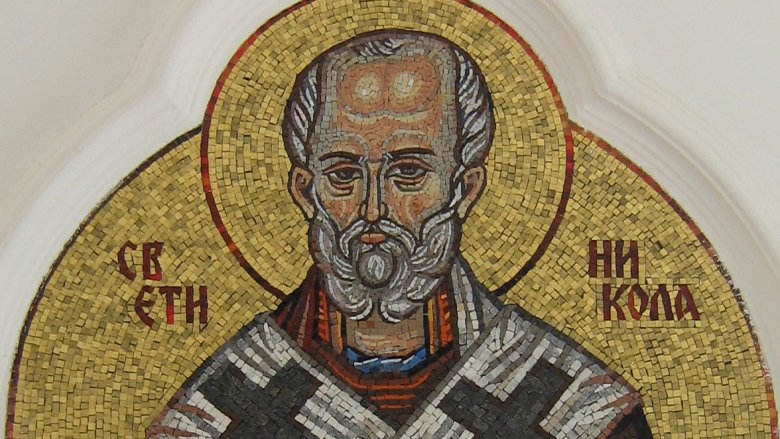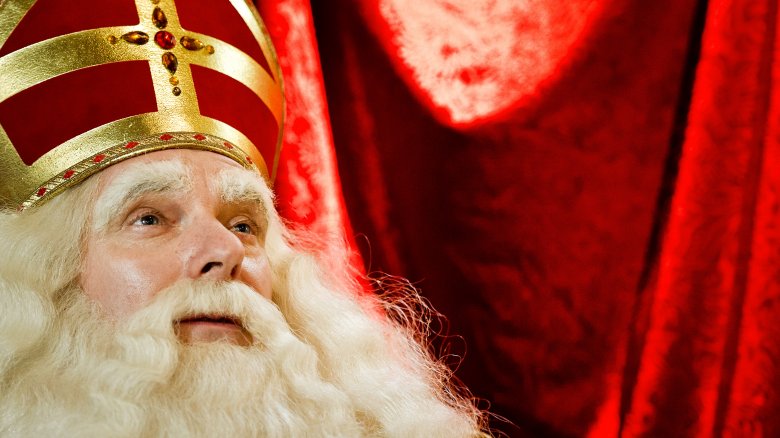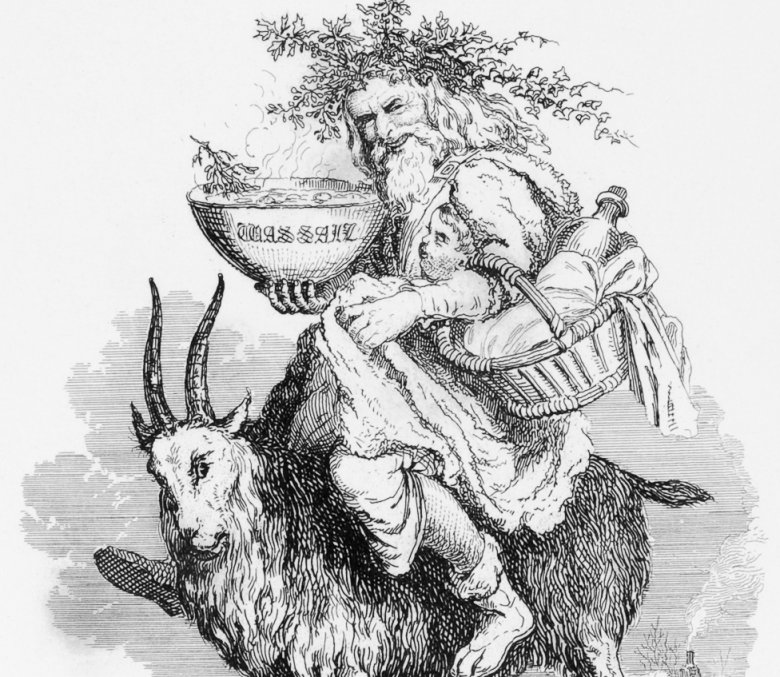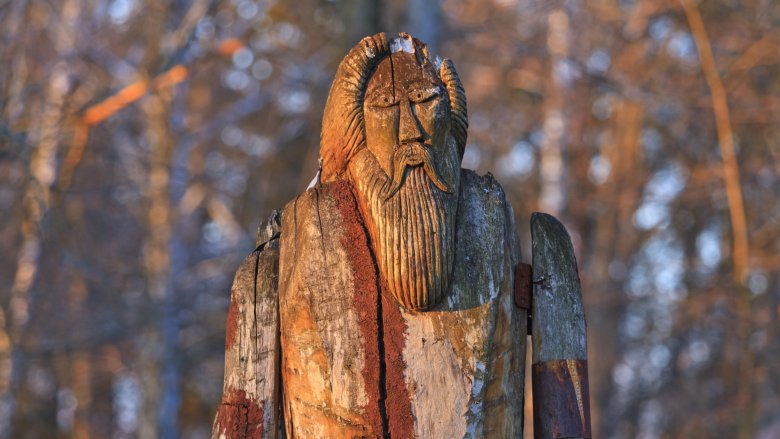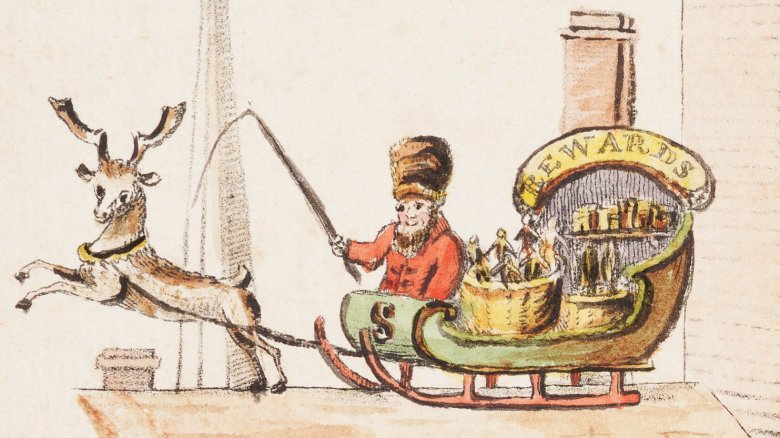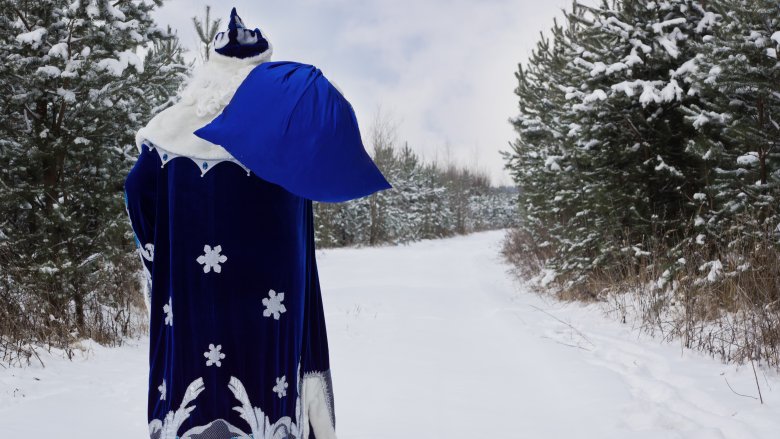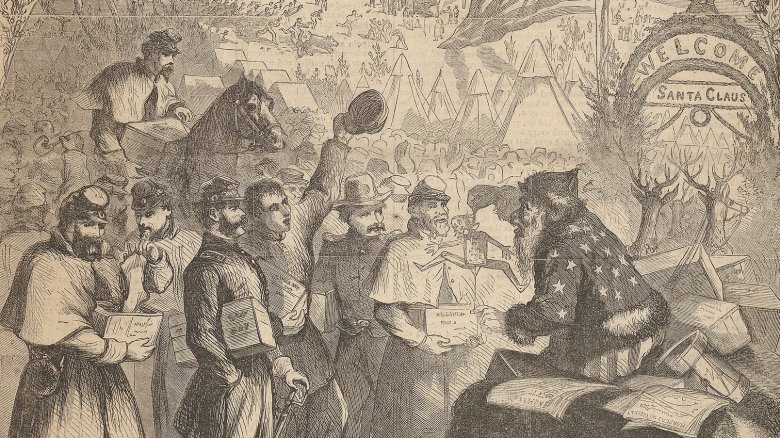The Untold Truth Of Santa Claus
We pretty much take Santa for granted these days — every Christmas, blizzard or no, he brings presents to all the world's believers without getting annihilated by the laws of physics. And yet we never really wonder where the heck the man in red came from, what his story is, or why he doesn't get annihilated by the laws of physics. Now here it is at last, the mostly complete, untold truth of Saint Nick.
The real Saint Nicholas
In or around the year 270 A.D., a man called Nicholas was born somewhere in Turkey. Coincidence the first: Christmas turkeys. Anyway, according to NBC News, Nicholas became a bishop as a young man, which must have pleased the hell out of his mom. He then became locally famous for anonymously paying the dowries of girls from poor families. Apparently anonymity was hard, since he became famous for it.
Nicholas was also known for leaving coins or other treats in the shoes of local children, and eventually the little punks came to expect it and would leave their shoes out on purpose in the hope of finding something good inside them the next day.
In traditional images, Nicholas is usually portrayed wearing a red cloak, much like our modern Santa only more bishopy. He is also said to have had a small orphan boy working as his helper, who was more or less the first elf.
Nicholas died on December 6, which is well within the season of holiday shopping frenzy, and was shortly thereafter canonized as the patron saint of children. After his death, people honored him each year with a December 6 feast and carried on the tradition of leaving gifts in children's shoes.
Sinterklaas
For a while, St. Nicholas was mostly a Dutch thing. Protestantism frowned upon the celebration of saints as a form of idolatry, so parents had to tell their kids that not only was St. Nicholas forbidden but also they wouldn't be getting any presents on December 6. Now just imagine for a moment if everyone said that to their kids today: "Santa Claus is an idol and therefore won't be coming to our house anymore." The utter annihilation of innocence and magic would probably plunge the world into a nuclear winter.
After St. Nicholas got the Protestant boot, people mostly stopped celebrating December 6, with the exception of the Dutch, who were all, "To hell with you and your dumb rules" and went on with the feasting and the gift giving anyway.
According to Business Insider, the Dutch called Nicholas "Sinterklaas." Sinterklaas was the rough outline of our modern Santa — not only did he do the whole leaving-gifts-in-shoes thing, he also wore the red bishop's robes of the original St. Nick. By the Middle Ages, he was assisted by elves, he had some cool Santa magic that got him out of chimneys, and although he hadn't yet discovered flying reindeer he did seem to have at least one flying horse. Incidentally, in order to get a gift you were expected to leave some treats out for the horse, which explains why Sinterklaas hadn't yet reached traditional Santa Claus rotundity. (Cookies would come in later centuries.)
Father Christmas and those creepy German gift-givers
Other European cultures maintained some form of St. Nicholas, too — in Britain he was known as "Father Christmas," though back then he was mostly just an annoying guy who wandered around town and invited himself over to random houses for Christmas dinner. Besides being the ancient equivalent of that lonely guy at work who's always hinting that maybe he should come over to your house for Christmas this year, Father Christmas lived in the far north, which explains why no one was ever able to track him down and arrest him for trespassing and home invasion.
As if Father Christmas wasn't weird enough, there were also the German gift-givers, who were a clever way of skirting the Protestant moratorium on St. Nicholas. According to National Geographic, the Germans just moved the gift-giving day to Christmas because who could argue with that? There were a few logistical problems to sort out, though — since Baby Jesus was technically an infant and therefore unable to carry 330 million gifts around, the Germans gave him some assistants. These assistants weren't jolly, though, because the Germans also knew that you could make kids behave by saying things like "he sees you when you're sleeping," which is freaking terrifying. So the German gift-givers brought gifts but also whipped or kidnapped naughty kids, which made them early versions of modern Stalker Santa.
Santa has Norse genetics
Long before the Germans, the Norse had their own story of a terrifying gift-giver who would show up during the winter festival. According to the Norwegian American, on the night of the winter solstice, the God Odin would fly around on an eight-legged horse, terrorizing anyone unfortunate enough to be out after dark, which kinda sounds like it might be the origin story for Grandma Got Run Over by a Reindeer.
If he got bored with the whole running-down-innocent-pedestrians thing, Odin might also turn into smoke and come down your chimney, which is obnoxiously creepy. It's so creepy that it's a wonder most Norse children didn't die from heart attacks when they began to understand that a psychopathic god was going to turn into smoke and come down their chimney. Still, kids would leave their boots next to the fire and then cower in terrified anticipation, and if Odin was feeling generous he would fill their boots with candy and toys. If you thought it couldn't get creepier than those German gift-givers, well, it could and it definitely did.
Early stories and poems
Once in America, all these different versions of Saint Nicholas mingled and popularized until one day in 1809 when Washington Irving decided to put a sort of merged version of them into a book called Knickerbocker's History of New York. The story was the first to portray St. Nicholas in a flying wagon, delivering presents only to well-behaved kids. (Everyone else got a switch.)
A few years after History of New York, The Saint Nicholas Center tells us that an anonymous author published an illustrated poem called "The Children's Friend," which gave St. Nicholas a new name: Sante Claus. In this portrayal, Sante Claus came from the north in a sled pulled by a single reindeer, and he arrived on Christmas Eve. He also brought only toys that weren't annoying, which meant no drums or toy pistols, and presumably nothing that comes in impenetrable plastic bubbles that can only be breached with a large steak knife with millions of twist ties that have to be individually undone while the gift recipient whines with righteous impatience. The good old days.
The Night Before Christmas
According to Business Insider, Santa Claus as we know him arrived in 1822, a fully fleshed-out amalgamation of St. Nicholas, Sinterklaas, Odin, those creepy German gift-giving stalkers, Father Christmas, and Sante Claus. In "Twas The Night Before Christmas," which is still a traditional Christmas Eve read for families all over the world, Santa was portrayed as a rotund, "jolly old elf" who arrived in a flying sled pulled by not one but eight reindeer. Santa and his posse were diminutive, which explains how he could get down the chimney, but other than that they were pretty much exactly as we know them today.
Since its original publication, "Twas The Night Before Christmas" has been reprinted more times than anyone can count, in more languages than anyone can say, which is a crazy amount of pressure to put on the man in red, who started life delivering gifts to a few village kids in Turkey and now has the monumental task of spoiling the entire surface of the planet. Although we hate to think of Santa as ever being anything less than jolly, it's probably a safe bet that he occasionally gazes in resentment at that original copy of "Twas The Night Before Christmas."
Stalin banned Santa Claus in Russia
Because communism is all about making everything not as much fun anymore, the rise of the Soviet Union was followed almost immediately by the fall of Santa, or "Father Frost" as he was known in Russia. Like Sinterklaas, Father Frost brought gifts to children on Christmas, and the communists just couldn't have that, because ... no one is exactly sure but it probably had something to do with communists being giant poopy-heads.
Communism wasn't terribly popular with the people, although no one could actually say so out loud, but Business Insider says that by the 1930s Joseph Stalin was starting to get that his people weren't exactly throwing roses and underpants at him when he appeared in public. So he brought back holiday gift giving, but at New Years instead of Christmas. That was okay, apparently, because New Years was a secular holiday and therefore magical, gift-bringing elves could show up as long as they didn't have anything to do with Jesus, or something. Stalin even put Father Frost in a blue coat instead of a red one, just so no one would confuse him with Santa, who was totally different even though the two traditions were, you know, pretty much exactly the same.
Santa didn't have a wife until 1849
The original Saint Nicholas didn't have a wife because bishops mostly didn't do that in the fourth century A.D. Still, according to Mental Floss, Santa remained mysteriously unwed until the middle of the 19th century, which ultimately shouldn't surprise anyone. Just imagine his Match.com profile: "I enjoy long walks in the subzero temperatures north of the Arctic circle, I work 365 days a year and subsist on a diet of cookies and candy canes, I put spy cameras in the homes of small children and I have 17,000 roommates, but they're all really short and don't eat very much."
Despite all the obvious lifestyle barriers between Santa and pretty much anyone he wanted to ask out, in 1849 the first reference to a Mrs. Claus finally appeared in a short story entitled "A Christmas Legend," which featured a young couple who disguised themselves as Mr. and Mrs. Claus. That was evidently enough to get the snowball rolling, and today Mrs. Claus appears in a lot of popular stories, although she's never really evolved beyond the 1950s housewife stereotype, urging her man to eat more so he'll be properly jolly on Christmas Eve. Hey storytellers, let's have a feminist Santa please — can we have her wearing a power suit, arranging toy deliveries, and firing slacker elves? That would be cool.
Santa's suit and the North Pole
Most of the various Santa Claus incarnations have worn some version of the red suit he wears today, from a long bishop's robe to a fur-trimmed coat. But at some point Santa's garb became standardized, and it was mostly thanks to the popularity of printed magazines like Harper's Weekly. According to History, in 1881, cartoonist Thomas Nast drew an image of Saint Nicholas that was based on his description in "Twas The Night Before Christmas." Nast's drawings included the fur-trimmed suit, thick white beard, and plump belly we know today, along with one of the first images of Mrs. Claus.
Incidentally, Nast was also the guy responsible for popularizing the idea of a Santa-led North Pole workshop. It's pretty easy to see why — the North Pole was always cold and snowy, and Christmas was associated with cold, snowy temperatures. The North Pole was also kind of romanticized since it was remote and there were lots of explorers who fantasized about being the first to reach it. But more importantly, it was the most logical place for Santa to hide a giant workshop full of elves because no one had ever actually been there and could therefore not say with any certainty that there wasn't a giant workshop full of elves up there. Logic. Keep the dream alive.
Thanks, Coca-Cola
Modern advertising is so despised by all that companies have invented devices that can fast-forward through ads, which is such an effective strategy that those same companies then have to figure out how to advertise because everyone is always fast-forwarding through their commercials. But try as we do, we have not been able to completely exorcise advertising from our lives and we're all pretty annoyed about it. However, it's worth remembering that much of our culture has been shaped by advertising, and even some of our beloved traditions would not exist in their current incarnations if multimillion-dollar companies had not deemed it so.
According to Business Insider, in the 1920s Coca-Cola was feeling annoyed because no one thought that an ice-cold Coke sounded good in subzero temperatures. So instead of inventing Hot Coca-Cola, which kind of would have made more sense (though it does sound horrifically disgusting), they decided to start aggressively marketing Coke as something that you could enjoy during the holidays. They hired an illustrator to create a Santa Claus with a jolly face and a lovable demeanor to help counter some of the still-lingering stalker versions of Santa Claus. And then for some reason they featured him doing questionable things like stealing Coke out of people's refrigerators, which really is not modeling good behavior for little kids, but whatever. The jolly, friendly version of Santa persisted, and that's mostly how we still imagine him today.
The real face of Santa revealed
Because researchers just couldn't leave well enough alone after centuries of Santicular evolution finally gave us a standardized version of Santa for most of the world to agree upon, The Saint Nicholas Center reports that in the 1950s someone had the bright idea to dig up the bones of the real St. Nicholas and then in 2014 researchers used the measurements of his skull to forensically reconstruct his face. We're all pretty universally certain that Santa's a jolly, chubby guy with a long white beard and rosy cheeks, so why mess with a good thing? Because science, that's why.
Researchers painstakingly reconstructed St. Nicholas's face and discovered, shockingly, that he'd looked pretty much exactly like he did in his ancient portraits and less like his modern Coca-Cola ones. But hey, it's not like all the money that was spent on that particular project could have been used for stuff that is actually useful to know and also does not have the potential to confuse millions of children, right? Of course not.
Santa's monumental task
Much has been said about Santa's strange ability to achieve the superhuman feat of visiting every child in the world in a single night. According to ABC News, there are around 2.2 billion kids in the world, but most of them don't celebrate Christmas and so would not be on Santa's list. That leaves 330 million kids, and if you assume that each house has approximately 2.5 kids living in it, that's 132 million homes. If Santa flies in the right direction and works only after dark, he's got around 31 hours to complete every delivery. That works out to around 1,178 homes per second.
There's also the weight of Santa's sleigh to consider — assuming he's only delivering one toy per child (which would cause an awful lot of spoiled kids to lose their minds on Christmas morning, by the way, but let's continue), his sleigh would have to weigh 660 million pounds, and he'd need 220,000 reindeer to pull it. What's more, those reindeer would have to be traveling at 7,800 times the speed of sound.
That's a lot of calculations, mathematicians. Well done, but there's really a much more logical explanation for Santa's annual achievement, so let's just stick with that one: magic plus Christmas spirit.
Santa and the theory of relativity
Just in case all that stuff about Santa and his 220,000 reindeer totally messed you up in the head, here's some more science for you. According to Phys.org, a physicist at the University of Exeter says that Santa could be moving so fast that, according to Einstein's theory of relativity, he would shrink, which would pretty conveniently make it possible for him to fit down the chimney or through the keyhole in your front door. Because things that move at those speeds don't get any older, the theory of relativity also explains why Santa is still around more than a thousand years after he was born. So ultimately what this really says is that science doesn't always have to spoil everyone's fun. (Looking at you, facial reconstruction people.)
Sleds aren't practical everywhere
Santa Claus's favorite mode of transportation is obviously the sled, which is pretty handy for getting him out of the ice-clogged North Pole. But not everywhere on the planet is blanketed with snow during the holidays — in Australia, for example, Christmas is a summer holiday, and a reindeer-pulled sled wouldn't really be very practical.
As it turns out, Santa trades in his sled for a different mode of transportation quite often during his Christmas Eve journey. According to the Huffington Post, in the Netherlands (where he's still known as Sinterklaas), he arrives by steamboat. In Australia he trades the reindeer for white kangaroos, also called "boomers." In France he's called Pere Noel, and he shows up riding a donkey named Gui.
Whatever the tradition, Santa is still pretty much Santa, even when he appears as 13 "Yule Lads," who come down from the mountains to either give kids presents or rotten potatoes (the Icelandic version of coal). Regardless of what he looks like, what mode of transportation he uses, or how fat and jolly he is, the legend of Santa is still magic for millions of kids, with a cool history that makes his tradition especially sweet.

